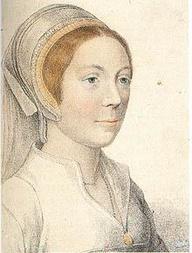 On 11th November 1541 the King’s Council sent Archbishop Thomas Cranmer a letter giving him instructions to move Queen Catherine Howard from Hampton Court Palace to Syon House, formerly Syon Abbey:
On 11th November 1541 the King’s Council sent Archbishop Thomas Cranmer a letter giving him instructions to move Queen Catherine Howard from Hampton Court Palace to Syon House, formerly Syon Abbey:
“First, the King’s pleasure is, that the Queen, with convenient diligence, remove to the house of Syon, there to remain, till the matter be further ordred, in the state of a Queen, furnished moderately, as her life and conditions have deserved; that is to say, with the furniture of three chambers hanged with mean stuff, without any cloth of astate; of which three, one shall serve for Mr Baynton, and thothers, to dine in, and thother two, to serve for her use, and with a mean numbre of servants, according to a book which wee send unto you herewith…”1
The letter went on to say that the Queen was allowed to have “four gentlewomen, and two chamberers” of her choosing, although the King wanted Lady Baynton to be one of the ladies and for her husband, Sir Edward Baynton, to be in charge of the household. The King’s almoner, Nicholas Heath, Bishop of Rochester, was also sent there.
Although her jewels had been seized, a letter from Ralph Sadler, one of the King’s Secretaries of State, to Archbishop Cranmer states that the Queen was sent six French hoods edged with “goldsmith’s work”, six pairs of sleeves, six gowns, and six kirtles of satin damask and velvet.2 Catherine was to enjoy these luxuries while further investigations were carried out.
The 11th November also seems to be the day when Catherine’s alleged relationship with Thomas Culpeper came to light. Under interrogation about his own relationship with the Queen, Sir Francis Dereham stated that since Catherine had married the King “Colpepre had succeeded him in the Queen’s affections”. This revelation resulted in Catherine being interrogated again and Thomas Culpeper being questioned. The King’s mercy was just about to come to an end.
Trivia: Sir Edward Baynton served as Vice Chamberlain to Queens Anne Boleyn, Jane Seymour, Anne of Cleves, Catherine Howard and Catherine Parr. His wife, Isabel (née Legh), was Catherine Howard’s half-sister and had been serving Catherine since her marriage to the King.
Also on this day in history…
- 1534 – Philippe de Chabot, Seigneur De Brion and Admiral of France, landed at Dover and was met by George Boleyn, Lord Rochford. George had been chosen by Henry VIII to escort the Admiral to London, no easy task when the Admiral had a huge train consisting of over 350 horses! Read more about this in my article George Boleyn, the Admiral of France and an Angry Anne Boleyn.
Notes and Sources
- State Papers: King Henry the Eighth; Parts I. and II, Volume 1, p691
- Ibid., p694